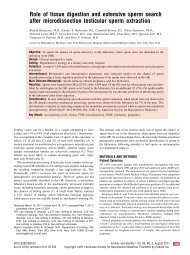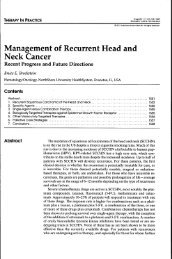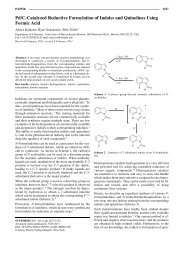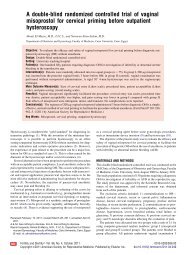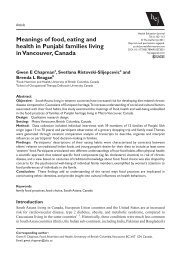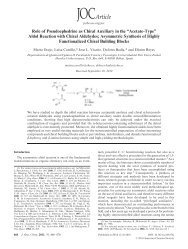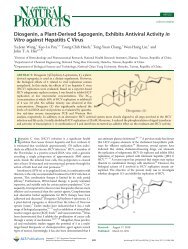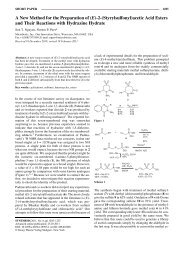Cardioscopy-guided surgery: Intracardiac mitral and tricuspid valve ...
Cardioscopy-guided surgery: Intracardiac mitral and tricuspid valve ...
Cardioscopy-guided surgery: Intracardiac mitral and tricuspid valve ...
You also want an ePaper? Increase the reach of your titles
YUMPU automatically turns print PDFs into web optimized ePapers that Google loves.
ET/BS<br />
Evolving Technology/Basic Science Shiose et al<br />
Abbreviations <strong>and</strong> Acronyms<br />
CPB ¼ cardiopulmonary bypass<br />
LA ¼ left atrium<br />
LV ¼ left ventricle<br />
PA ¼ pulmonary artery<br />
RV ¼ right ventricle<br />
was inserted into the left internal thoracic artery, <strong>and</strong> the pressure was measured<br />
during the procedure. The pericardium was opened widely. The superior<br />
<strong>and</strong> inferior venae cavae <strong>and</strong> the main pulmonary artery (PA) were<br />
exposed <strong>and</strong> isolated. A 24F arterial cannula was inserted into the ascending<br />
aorta through purse-string sutures, <strong>and</strong> short <strong>and</strong> long versions of an<br />
L-shaped 28F venous cannula were inserted, respectively, into the superior<br />
vena cava <strong>and</strong> the right atrium-inferior vena cava toward the inferior vena<br />
cava. A 20F cannula was inserted into the PA to perfuse the lactated<br />
Ringer’s solution. A fluid-filled line was inserted into the left atrium (LA)<br />
to monitor LA pressure. After full heparinization (300 U/kg), CPB was initiated<br />
<strong>and</strong> systemic flow was maintained at 5.0 L/min. A 24F soft venous<br />
perfusion cannula was also inserted into the LA. A gastroscope (Olympus<br />
GIF-130, 9.8 mm, 103 cm; Olympus, Center Valley, Pa) was used as a cardioscope.<br />
The cardioscope, enclosed in a translucent outer sheath, was inserted<br />
into the left ventricle (LV) through the anterior middle-apex LV wall<br />
directly. The outer sheath was specially designed <strong>and</strong> made of polyurethane<br />
(Figure 1). A communicating space between the distal end of the cardioscope<br />
<strong>and</strong> the sheath allowed the infused solution to clear the area in front<br />
of the lens of the cardioscope effectively. A 32F soft venous cannula was<br />
inserted into the LV apex to drain the solution (Figure 2).<br />
First, the main PA was clamped at the proximal site of the inserted cannula,<br />
<strong>and</strong> 1.0 L of the normothermic lactated Ringer’s solution was administered<br />
for 1 minute at the rate of 1.0 L/min to the distal PA to flush out any<br />
remaining blood in pulmonary vasculature using a separate pump. The ascending<br />
aorta was not clamped, <strong>and</strong> the irrigated fluid was drained mainly<br />
from the LV cannula. Hemodilution was avoided by using CAPIOX Hemoconcentrators<br />
(reference 62648; TERUMO, Elkton, Md) continuously<br />
throughout the experiment. Then, the solution was administered through<br />
the LA before left-side visualization (2.0 L/min, 1 minute). LA pressure<br />
was kept at less than 10 mm Hg to avoid heart distention. During visualization<br />
of the LV, the solution was continuously infused through the outer<br />
sheath at a rate of 2.0 L/min. Both the mid portion of the anterior <strong>and</strong> posterior<br />
leaflets of the <strong>mitral</strong> <strong>valve</strong> were approximated with an endoscopic<br />
clip (Olympus, HX-201UR-135L, http://www.olympuskeymed.com/<br />
index.cfm) introduced through the cardioscope, in a fashion similar to<br />
interventional edge-to-edge repair. 5 An endoscopic clip was proceeded to<br />
the leaflets <strong>and</strong> opened. In most of the cases, the leaflets were caught by<br />
FIGURE 1. Cardioscope <strong>and</strong> the outer sheath. The holding fixture (A)<br />
with several holes is applied to place the scope at the center of the sheath.<br />
Clear lactated Ringer’s solution is infused from the side hole of the outer<br />
sheath (B) to clear the area in front of the lens of the cardioscope through<br />
the holes of the fixture. White arrows show the direction of the flow of clear<br />
solution. The proximal part of the outer sheath is snared to infuse the solution<br />
only toward the heart.<br />
200 The Journal of Thoracic <strong>and</strong> Cardiovascular Surgery c July 2011<br />
both ends of the clips at the systolic phase, <strong>and</strong> then the leaflet captures<br />
were performed by just closing the clips. After de-airing of the LV, the<br />
LV <strong>and</strong> LA cannulae along with the cardioscope were removed <strong>and</strong> the<br />
PA was declamped. The calves were weaned from CPB supported with<br />
a low dose of dobutamine, <strong>and</strong> hemodynamics after weaning from CPB<br />
were confirmed to be stable for 10 minutes.<br />
CPB was resumed for the repair of the <strong>tricuspid</strong> <strong>valve</strong>. A 24F soft<br />
venous cannula was inserted into the right atrial appendage to perfuse<br />
the solution (Figure 3). The coronary sinus was occluded epicardially.<br />
Both venae cavae were occluded for total bypass. The cardioscope within<br />
its sheath was inserted into the right ventricle (RV) through the anterior<br />
middle RV wall. The PA was clamped distally from the PA cannula, which<br />
enabled the complete isolation of the right heart. The solution was administered<br />
continuously through the outer sheath (2.0 L/min). The edges of the<br />
anterior <strong>and</strong> septal leaflets were approximated with the clip introduced<br />
though the cardioscope. After weaning the animal from CPB with dobutamine,<br />
stable hemodynamics were confirmed for 10 minutes. All video<br />
images were recorded digitally at the time of the experiment<br />
(Sony DCR-TRV480; Sony Corp, Tokyo, Japan). Hematocrit values were<br />
measured hourly throughout the procedure.<br />
Autopsy Evaluation<br />
After the completion of the procedure, the animals were killed by intravenous<br />
administration of potassium chloride (240 mEq) under deep anesthesia<br />
with 5% isoflurane. The clips were accessed from the right<br />
atrium, RV, <strong>and</strong> LV with the heart still in the chest. After excision of the<br />
heart, the clip on the <strong>mitral</strong> <strong>valve</strong> was evaluated from the LA. The intracardiac<br />
structures were evaluated macroscopically.<br />
FIGURE 2. Schema of the actual surgical approach to the <strong>mitral</strong> <strong>valve</strong>.<br />
CPB is established between the venae cavae <strong>and</strong> aorta. The cardioscope,<br />
enclosed in its sheath, is inserted from the LV anterior middle-apex. The<br />
cannulae by which the solution is infused are inserted into the PA <strong>and</strong><br />
LA. The drainage cannula for a solution is inserted into the LV. The<br />
main PA is clamped to reduce the amount of blood returning to the left<br />
heart. Ao, Aorta; PA, pulmonary artery; LA, left atrium; LV, left ventricle;<br />
RA, right atrium; RV, right ventricle; SVC, superior vena cava; IVC, inferior<br />
vena cava; CPB, cardiopulmonary bypass.



